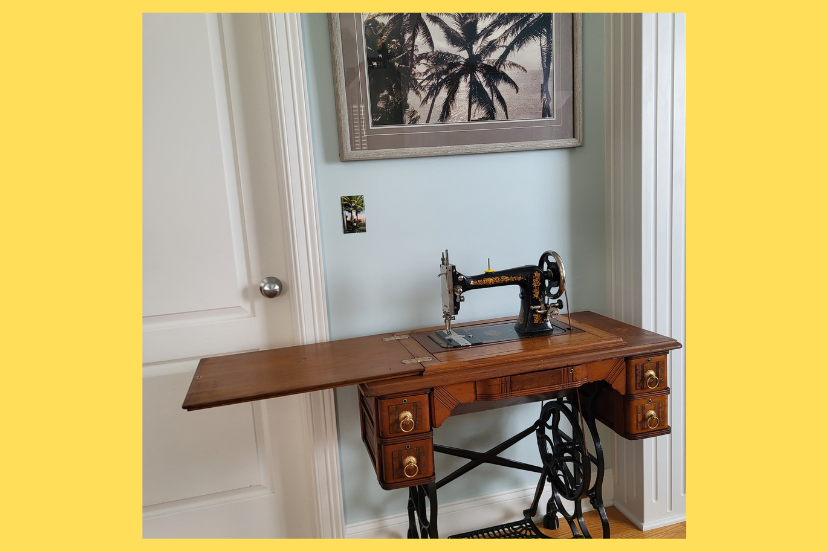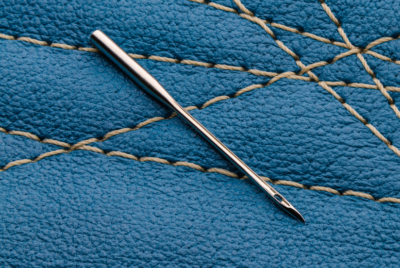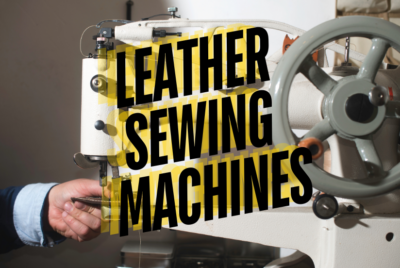Preserving Your Vintage Sewing Machine
Once you start collecting, preserving your vintage sewing machine should be a priority. Regular maintenance is required. Being able to troubleshoot some common problems is a valuable skill to learn. This is especially true if you are using your treasured sewing machine to produce cherished pieces of work.
Although you can certainly enlist the services of a professional, regular inspections with some simple maintenance will ensure your sewing machine’s functionality will continue. It will definitely add to its longevity. Combined, these will keep your sewing machine as a treasured heirloom for future generations.
Some products we have used for refurbishing vintage sewing machines, can also be used for regular maintenance to preserve your vintage sewing machine. Our post, “Vintage Sewing Machine Restoration Products” describes some you might find useful.
Following these basic procedures will save you time and money while preserving your vintage sewing machine. Here are some key aspects to consider.
Preserving Your Vintage Sewing Machine
Regular Cleaning
Dust and dirt can accumulate on vintage sewing machines over time, affecting their performance and appearance.
Develop a regular cleaning routine using soft brushes, lint-free cloths, and gentle cleaning solutions. Pay special attention to delicate areas such as the decals, moving parts, and internal mechanisms.
Avoid using harsh chemicals or abrasive materials that could damage the machine’s finish.
Lubrication
Proper lubrication is essential for keeping your vintage sewing machines running smoothly.
Consult the manufacturer’s guidelines or seek advice from experienced collectors or repair specialists to determine the appropriate lubricants and lubrication points for your specific machines.
Apply lubricant sparingly and wipe off any excess to prevent accumulation of dust and debris.
Electrical Safety
If you have electric vintage sewing machines, it’s crucial to prioritize electrical safety. Inspect the cords, plugs, and switches for any signs of damage or fraying.
If necessary, replace worn-out or faulty electrical components with the help of a qualified professional.
Remember to unplug the machines when not in use and avoid exposing them to excessive heat or moisture.
Storage
When not in use, store your vintage sewing machines in a clean and dry environment, away from direct sunlight or extreme temperature fluctuations.
Consider using dust covers or cases to protect them from dust, moisture, and potential damage.
Avoid storing them in basements, attics, or other areas prone to high humidity, as this can lead to rust and deterioration.
We have noticed on a number of occasions that the tops of cabinets for storing vintage sewing machines have been used for displaying other treasured heirlooms or flower vases. If you are planning to do this be sure to adequately protect the surface of the cabinet.
Removing water stains can be difficult. Also, be aware that the exposed top surfaces of a cabinet or its extendable table might be a venier. Restoring this type of surface requires special attention.
Following the guidelines below will help to maintain a working machine. If you decide to look for a model that you will need to refurbish, we have a resource to help guide you. Some products we use for refurbishing, can also be used for maintenance. A few of the products we use for refurbishing can also be used for maintenance. Here are some products for you to consider,
Professional Maintenance
Periodically, it’s beneficial to have your vintage sewing machines professionally serviced and inspected by a skilled technician or repair specialist. They can identify and address any underlying issues, perform necessary repairs, and provide guidance on maintenance practices specific to your machines.
A professional touch can ensure the longevity and optimal performance of your collection.
Documentation and Record Keeping
Keep a record of the maintenance activities performed on each machine, including dates, repairs, and any replacement parts used. This documentation will not only help you keep track of the machine’s history but also prove beneficial when showcasing or selling your collection in the future.
Sewing Machine Safety Precautions
When you are operating any machine, safety is utmost important. Do a regular inspection of your sewing machine and its operation. Here are some of the safety precautions you should consider.
Read the Manual
Familiarize yourself with the manufacturer’s instructions and safety guidelines provided in the sewing machine manual. Each machine may have specific precautions to follow.
Realize vintage sewing machines often are missing their instruction manuals. You will need to spend some online work time to try to locate information about your vintage machine. Forums and groups might provide a valuable place to start.
Unplug when Not in Use
Always unplug your sewing machine when you’re finished using it or when performing maintenance tasks, such as changing needles or cleaning the machine.
Use a Grounded Outlet
Ensure that your sewing machine is plugged into a grounded outlet to prevent electrical hazards.
Proper Lighting
Work in a well-lit area to avoid eye strain and accidents. Consider using additional task lighting if needed.
Keep Fingers Clear
Avoid placing your fingers too close to the needle or other moving parts of the sewing machine while it is in operation. Always use tools like a seam ripper or tweezers to handle threads or remove fabric.
Wear Appropriate Attire
Avoid loose-fitting clothing, loose jewelry, or dangling accessories that can get caught in the machine. Roll up long sleeves and tie back long hair to prevent accidents.
Protect Your Eyes
Consider wearing safety glasses or goggles when dealing with sharp needles, trimming fabric, or handling small parts to prevent eye injuries.
Clean with Caution
When cleaning or oiling your sewing machine, make sure it is turned off and unplugged. Use a soft brush or lint-free cloth to remove lint or debris from the machine.
Store Properly
When not in use, cover your sewing machine to protect it from dust and ensure it is stored in a safe and dry location.
Educate Children
If there are children around, teach them about the potential dangers of sewing machines and keep them away from the machine when in use.
Seek Professional Help
If you encounter any mechanical or electrical issues with your sewing machine that you cannot solve, consult a qualified technician or service center for repairs.
When you purchase a new sewing machine, avoid attempting repairs yourself, as it may void the warranty or result in further damage.
Common Problems
Although there can be a wide range of issues, as with any machine, here are some of the most common.
Thread Tangles and Snags
Problem: Your thread keeps tangling or getting caught in the machine.
Solution:
- Start by removing the tangled thread completely.
- Rethread the machine carefully, making sure the thread is properly seated in the tension discs and the thread path.
- Check if the needle is inserted correctly and not damaged. Replace if necessary.
- Use a good quality thread appropriate for your fabric.
- Adjust the tension settings gradually, testing on a scrap fabric until the stitches look balanced.
Skipped Stitches
Problem: Your machine is skipping stitches, leaving gaps in the fabric.
Solution:
- Begin by replacing the needle with a new one, as a dull or bent needle can cause skipped stitches.
- Make sure you’re using the correct needle size and type for your fabric.
- Check the needle position and ensure it is fully inserted and facing the right way.
- Clean the machine’s bobbin case and feed dogs, removing any lint or debris.
- If the problem persists, adjust the thread tension slightly, testing on scrap fabric until the stitches are consistent.
Uneven or Loose Stitches
Problem: Your stitches are uneven in length or appear loose.
Solution:
- Ensure that the upper thread is properly threaded through the machine, including the tension discs.
- Check the bobbin thread for proper winding and insertion.
- Adjust the thread tension gradually, testing on scrap fabric until the stitches look even and secure.
- Verify that the presser foot pressure is correctly adjusted for your fabric thickness.
- Clean the feed dogs and remove any lint or threads that may be obstructing smooth fabric feeding.
Machine Jamming
Problem: Your machine is frequently jamming, causing frustration.
Solution:
- Turn off the machine and unplug it from the power source.
- Carefully remove the fabric and any tangled threads or obstructions from the needle area.
- Check the bobbin area for any loose threads or lint, and clean it thoroughly.
- After reassembling, test the machine with a scrap fabric to ensure it is running smoothly.
- Regularly clean and oil your machine as per the manufacturer’s instructions to prevent future jams.
Noisy Operation
Problem: Your sewing machine is making unusual noises or vibrations.
Solution:
- Check that the needle is inserted correctly and is not bent or damaged.
- Tighten any loose screws or components in the machine.
- Clean the machine, removing lint or debris that may be causing the noise.
- If the noise persists, consult your machine’s user manual or contact a professional for further assistance.
Final Thoughts: Enjoyment and Use
Preserving your vintage sewing machine is important. Regular inspections and maintenance will help achieve that goal. These machines were designed to be used, so take the time to sew with them and appreciate the craftsmanship and functionality they offer.
Regular use can help keep the internal components in good working order and prevent issues that may arise from extended periods of inactivity.
Following essential safety precautions and knowing how to troubleshoot common sewing machine issues will help ensure a secure and enjoyable sewing experience
Embrace the responsibility of being a custodian of these historical artifacts, and with proper care, your collection will remain a testament to the timeless artistry of sewing machine craftsmanship.
RetroSewMachines.com is a participant in the Amazon Services LLC Associates Program. As an Amazon Associate, we earn from qualifying purchases. We also participates in other affiliate programs and may earn a referral commission if you purchase through links on this website. The information presented here is for general educational purposes only.





Comments are closed.